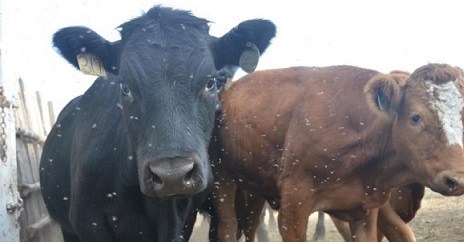
Introduction
Parasitic insects on milch animals cause lot of damage to livestock farmers. Although insects do not seem to be harmful, they can indirectly be a nuisance to animals and insects can transmit many diseases to animals and even weaken their immune system. Also, anemia can be caused by a deficiency of red blood cells (RBCs) in animals. Therefore, it is very important to control parasitic insects on the body of animals.
Normally drugs which are used to control parasites are toxic. They can cause poisoning. These drugs are mixed with water and sprayed on the body of the animal for controlling different types of parasites (lice, mites, fleas, flies, ticks, etc.).
Precautions to be taken while using this medicine:
- Drugs should not be allowed to come in contact with wounds, mouths or open areas.
- Watering the animals before using the medicine.
- Keep the animals in the shade while applying the medicine.
- Use the medicine after resting the animal for at least one to two hours after bringing it out of the sun or after hard work.
- The spray period between the two drugs should be at least one week apart.
The most important of the parasitic insects in cows and buffaloes is Ticks. Tropical or subtropical climate like India is conducive for ticks to grow almost all year round. Various studies has found that about 80% of the animals in the world are affected by ticks and the economic loss is very high.
Mostly outbreaks appear to be exacerbated during March-April to August-September. There are many species of Ticks in India. It is found that Hyalomma sp. and Boophillus sp. Commonly affect milch animals and reduces the ability of animals to work. It can paralyze animals, cause anemia, and sometimes increase the mortality rate in animals.
For controlling ticks, One should have full information on its life cycle, ticks take birth from eggs. After hatching, the young one absorbed blood and adult ticks is formed. Adult ticks need to absorb blood before reproduction. Ticks are mainly attached to the body parts of animals which are not easily cleaned by the animals. E.g., On the head, neck, ears, under the tail, on the inside of the thighs, near the anus, and on the groin.
For the eradication of ticks, it is necessary to clean the body of the animal as well as fill the grooves, cervices, incisions, etc. present in the animal sheds.
Elimination of ticks from animals:
Previously drugs like BHC or DDT were used for ticks’ eradication but these drugs have been found residual effects in animals and depict adverse effects on the human race. Because those drugs enter the human body through the consumption of milk and meat. Organophosphates, Carbamates, Synthetic pyrethroid’s, Acaricides, etc. are currently available in the market for the elimination of external parasites from the body of animals.
| Sr. No. | Name | Quantity | Used Against |
| 1. | Diazion | 3 ml /L Water | lice, mites, fleas, flies, ticks, etc. |
| 2. | Coumophos | 1 g / L Water | |
| 3. | Fenvalerate | 2 ml /LWater | |
| 4. | Cypermethrin | 1 g / L Water | |
| 5. | Amitraz | 2 ml /L Water | lice, mites, and ticks |
At present Ayurvedic medicines are also available in the market which can be used effectively for the eradication of external parasites from which there is no possibility of poisoning. E.g., extracts obtained from eucalyptus.
Elimination of ticks in the vicinity of the barn:
Acaricides and weedicides should be sprayed on the ground, walls, in the barn, and on the grazing area around the barn to control the external parasites and weeds respectively in the vicinity of the barn. To do this, choose the time after the rains have stopped. After spraying, a period of about 10 days should be allowed, and only after that feed the animals in the barn. The following drugs should be used for this.
| Sr. No. | Name | Quantity | |
| On the ground (%) | On the wall (%) | ||
| 1 | Melathion | 1.5 – 2.0 | 0.75 – 1.0 |
| 2 | Bitox | 2. 0 – 2.5 | 1. 5 |
| 3 | Cypermethrin | 1.5 – 2.0 | 1. 5 |

Sachin Dongare1, Indrayani Gawas2, Mohit Bharadwaj3, Manoj Kumar Singh4
1 Ph.D. Scholar, Department of Livestock Production Management, Govind Ballabh Pant University of Agriculture and Technology, Pantnagar
2 Ph.D. Scholar, Department of Plantation, Spices, Medicinal and Aromatic crops, College of Horticulture, Dr.Balasaheb Sawant Kokan Krishi Vidyapeeth, Dapoli Maharashtra
3 Ph.D. Scholar, Department of Animal Nutrition, Govind Ballabh Pant University of Agriculture and Technology, Pantnagar
4Assistant Professor, Department of Livestock Production Management, SVPUA&T, Meerut, U.P
Corresponding Author Email id- sachindongare12345@gmail.com

















